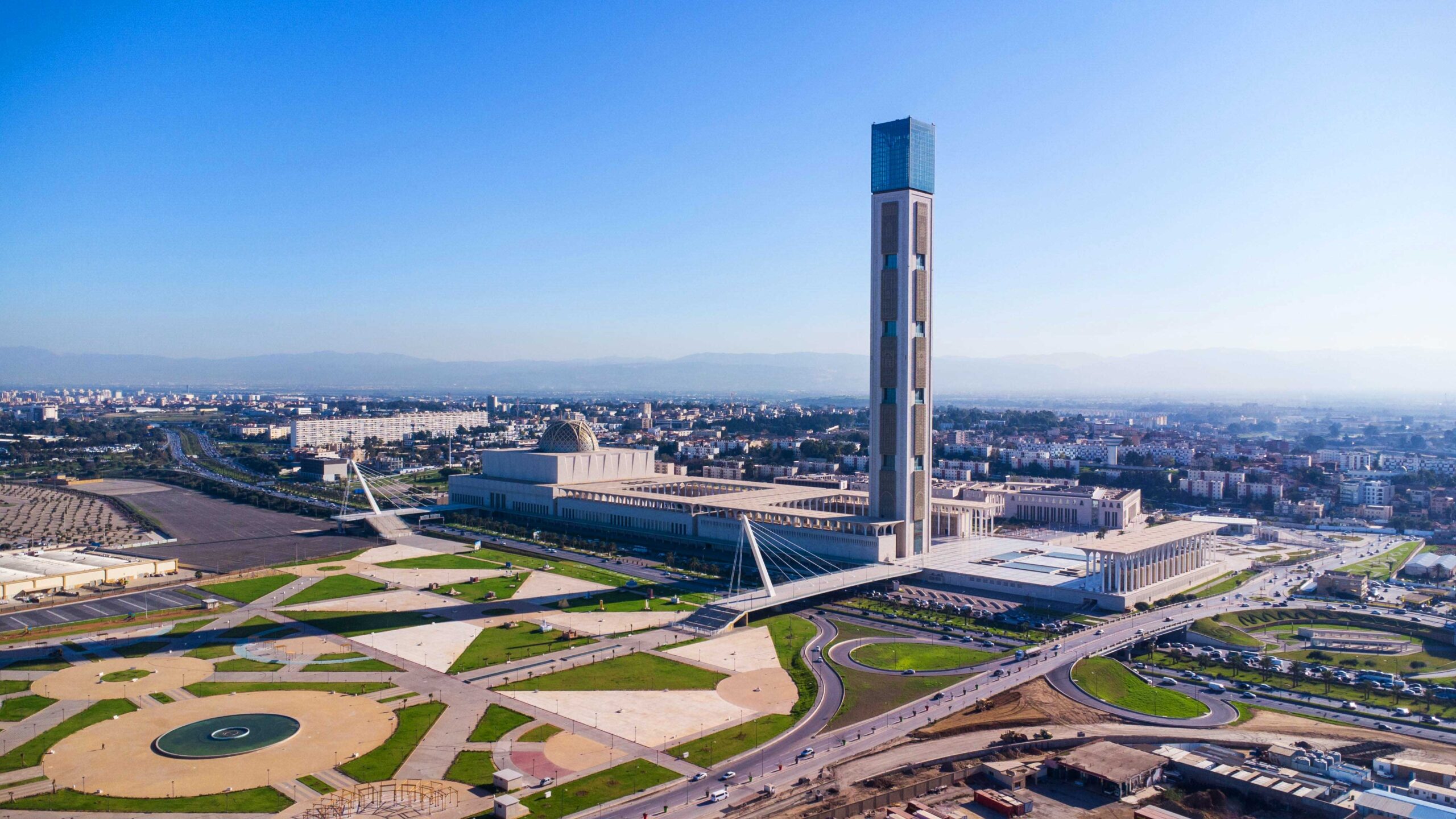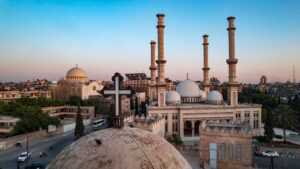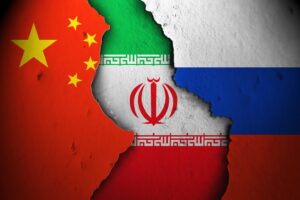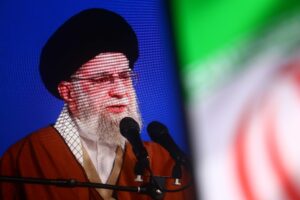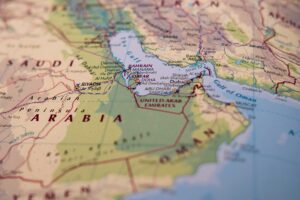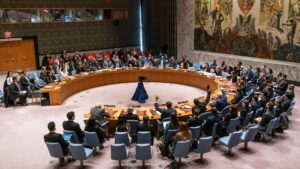Last year, an appalling headline read, “the biggest Mosque in Africa is now in Algeria, not Morocco”.[1] This was a notice of a broken record; a new landmark created by a ‘narcissist’. This news was about the admiration of the Djamaa el Djazaïr as the new biggest mosque in Africa, and most importantly, the tallest minaret in the world. In other words, a celebration that the Great Hassan II mosque in Casablanca has been ‘dethroned’ as the mightiest in Africa. It was confounding to contemplate that someone will surpass the record for the ‘vanity’ minaret of 200 metres after all the debauchery of squandered funds. Likewise, it was quandary to fathom that this new mosque was constructed purposely to outshine other mosques. Moreover, could this have been a ‘pious project’ that dissipated €1.2 billion[2] of public funds in Algeria when the citizens are suffering from basic amenities? The fuzzy logic to allocate considerable resources for a structure that is only utilized for Jum’ah prayer needs scrutiny. The mosque does not require a built structure in the first place. Regardless of the importance of a Mosque in a community, no liturgical provision warrants any structure because the whole earth has been made a place of prayer. Some of the archetypal examples of the Prophet’s mosque in Medina utilized ‘crude’ bricks. During the period of the Rashidun Caliphs, later evolutions had a trench to outline the boundary of the mosque in Kufa (637-638 A.D).[3] Comparing this with our contemporary practices, mosques now function as a tool for the ultimate expression of power and wealth in the region.
The Contagious Mosque Ambition
The ambition for State mosque is a pervasive leitmotif in the Middle East and North Africa. A major criterion for such endowment is a mesmerising structure that has superfluous decorations that are unprecedented in the community.[4] Currently, the relations between the Islamic countries has yielded a grand mosque as the symbol of their wealth in direct competition with their fellow neighbours. However, it would be unfair to ascribe this act of mosque propaganda as a phenomenon that started in the last decade. Several grand mosques were constructed throughout the apogee of Islamic culture. Even after centuries of construction, the glory of the Great Mosque of Damascus, Ibn Tulun and several other Ottoman mosques shine for all to see. However, the modern definition of ambitious state mosques coincides with the discovery of oil in the 1970s. The surge in the financial prowess in the region came with the concomitant ostentatious desires and global aspirations. Countries like Kuwait and Jordan created new mosque rhetoric to match their thriving environment. Without the context of need and functional integration, some of the symbolic element like the minarets and domes became a key part of mosques around the Gulf states.[5] The euphoria of independence from colonialism created an architectural ideology that is entangled with the concept of national identity and authenticity.[6]
Placing the occurrences in its right chronology will have the State mosque competition in Baghdad as the exacerbated ideology that divulges the propaganda in 1982. An international competition to create an outstanding edifice was organized for reputable architects. Seven prominent architects like Venturi, Bofill, Makiya, Badran, and Takeyama made the final proposals. Nonetheless, more than twenty architects were invited to partake in the competition. Each proposal from the architects has the ingenious definition of grandeur never seen before. While the project remained unbuilt, similar design competition became the popular trend as Muslim societies followed suit. Each successive State mosque construction evokes an obsession entwined with the ambition for the bigger and taller mosque in the region.
Hassan II mosque falls in the right place as a model of manufacturing consent to gain influence among the local community. This mosque evokes the essence of an audacious aspiration around a period marked with social unrest and financial hardship. The construction of the mosque started in 1986 to curb public disgruntle about the ruler. Perhaps, the renewed Islamic symbolism in countries like Iran reinforced the need to gratify the masses emotional attachment to religion. Hassan II embarked on the construction of 52 mosques[7] between 1981 and 1992 to change the foci of their national Departments of Public Works into religious missions in order to exempt themselves from political accountability, cover-up mismanagement of Public finances.[8]
Admittedly, the Hassan II mosque achieves the intent of the king as the “eighth wonder of the world”.[9] It is important to note that the desire for Sheikh Zayed Grand Mosque was initiated by the visit of the ruler to Casablanca in 1989.[10] Part of the key aspect of creating a monument is an isolated location where the magnificence of the mosque can be seen from a long distance. Some of the popular locations in areas like Turkey was the Hilltop or elevated ground where the adjoining structures cannot obstruct a view of the mosque. Hassan II mosque exudes the duality of view from both land and sea with the coastline location of the mosque. This became a design inclination in mosques like Djamaa el Djazair (c.2019) and Sheikh Zayed in Abu Dhabi (c.2007). With closer proximity to the sea coast, contemporary mosques diverge from the inland location in ancient Muslim society. Certainly, such trends adversely affect the use of the mosque because of the distance of travel to such location from the hub of the city.
At the same time, the cynosure mosques became gradually aggrandized in height with each successive construction. This leitmotif connotes that all the design architects carried out a detailed study of existing mosques as a means to create something grander. Perhaps this is linked with the superiority complex of the patrons and design architects. In the North African context, the Hassan II mosque has a prayer hall with 65 metres roofline while the Mosque of Algiers has a dome 70 metres high from the plain level. Even with the modern-day redundancy, the competition extends to the minarets with the former having 200 metres, while the later outshines it with a loftier 265 metres height. In the Middle East, the Grand Mosque of Kuwait (c.1986) is one of the most subtle with a dome and minaret of 43 and 74 metres height. Rising to a height of 50 and 95 metres respectively, the Sultan Qaboos mosque in Oman exceed the precedents in comparison with the dome and principal minaret. Being the most iconic, the Sheikh Zayed mosque crowns the glory with a central dome of 85m and four courtyard minarets, each exceeding 110 metres in height.
Decorative elements also fostered competition among the nations in the Middle East and North Africa. The interior hall of the Hassan II mosque has fifty-four Murano glass chandeliers to add glamour to the ambient decoration. Although this is sophisticated, it cannot be compared with the fascination of the subsequent mosques. At the time of its construction in 2001, Sultan Qaboos mosque has the largest chandelier made of Swarovski crystals and 24 karat gold. It has a mammoth length of 14.5 metres and was 8 metres in width. Interestingly, this record was broken by the Sheikh Zayed mosque with a similar piece of luxurious art that sparkle like diamonds. As insignificant as it is, a larger length of 15 metres and 10 metres wide was commissioned.[11] Moreover, it was the most expensive and cost more than US$ 8 million.[12] Going with the norms, the Djamee el Djazair imbibed a 400,000-crystal chandelier in the prayer hall. Similar milieu occurred with the floor carpet of the two Grand mosques in the Gulf States. The Omani mosque had the largest handmade carpet which covers the entire prayer sanctuary of 4263 sqm. The new carpet produced by the same company for Sheikh Zayed mosque has a larger size and cost more than US$ 8.5 million.[13]
In general, these mosques have the similitude in being national tourist attractions that are open to non-Muslim visitors. Their splendid architecture ranks high among the mosques in the world. Concomitantly, the construction of the Hassan II mosque has had recurrent repercussions on the animals and plants, whose ecosystem were destroyed on the coast. The building activities on the shoreline encroached more than 20 hectares of the Atlantic Ocean.[14] Moreover, the life expectancy of the pricy endowment is under analysis due to the viability of seismic activities on the shores.[15]
Similarly, huge resources were expended to achieve such splendour. The Hassan II mosque was funded by public subscription tangled with extortion. Money for the construction came from donations, tax, grants, and loans from western countries during a period when the country ranked high amongst the most indebted in the world.[16] Even though the official records has US$ 700 million, presumably the cost of construction was up to US$ 1 billion.[17] Moreover, the structure depleted double of the construction materials and was hypothetically built twice due to its deterioration after just 10 years of occupancy. Again, the restoration work between 2005-2008 cost as high as US$ 100 million.[18] Presumably, the recent mosques cost more. Irrespective of the €1.2 billion budget for Djamaa el Djazair mosque, it is plausible to suggest the project incurred more cost due to the construction delay of more than three years. The financial stability of Oman and Abu Dhabi place them in a safe zone as a country that could spend more on constructions. Moreover, the finishing works of Sheikh Zayed cost more than $ 450 million which makes speculation about the probable cost impalpable. It is important to note that this generalization about contemporary State mosque has an exception in the mosque of Imam AbdulWahhab In Qatar. Although its construction in 2011 will suggest a similar trend for the glory of vanity, it reclined from the tandem competition.
This exploration of the debacle of competition in State mosques demonstrates, among other things, that the irrelevant rivalry for taller structures can attest to the non-religious intent of most of the works. The human anthropometry does not warrant structure of such lofty height. Technological advancements have provided a better solution for the call to prayer that renders the minarets useless. No liturgical necessity warrants shimmering chandeliers with the tendency of distracting the worshippers. The large capacity of 20,000 to 120,000 worshippers of the state mosques suggests the need to have a space that provides for the sacred and secular need of the people. Moreover, resources that are meant for the development of the civic infrastructures were utilized for a structure that does not warrant a building in the first place. Indeed, the emergence of the state mosque created the divorce of the massive public works in the region.[19]
Furthermore, the competition for grander State mosques has little or no impact on the propagation of Islam. The influence of mosque tourism and ostentatious decorations has further reignited the ‘one thousand and one’ imagery of Islam to non-Muslims. Users’ perception of the mosques denotes emphasis on the architectural elements and embellishments rather than the spiritual function.[20] Likewise, contagious architectural desire is adversely affecting the cognitive understanding of mosques in the region. If not, there would be less concern about the Vali-e-Asr Mosque in Iran. It was declined by the local community as a mosque because of the dearth of visible dome and minaret.[21] Even when they have values that are core to the principles of Islam, the modest structures has a contradictory image to what they understand about mosques, The state of affairs is exacerbating and can further worsen if not addressed.
[1] Eliason, ‘The Biggest Mosque in Africa Is Now in Algeria, Not Morocco’.
[2] France-Presse, ‘Algeria Builds Giant Mosque with World’s Tallest Minaret’.
[3] Abdelrahman, The Influence of Hadith on the Architecture of Early Congregational Mosques, 251.
[4] Hillenbrand, The Sheikh Zayed Grand Mosque: A Landmark of Modern Islamic Architecture.
[5] Walsh, The Sultan Qaboos Grand Mosque.
[6] Vale, Architecture, Power and National Identity.
[7] Cattedra, ‘La Mosquée et La Cité’.
[8] Elleh, Architecture and Power in Africa, 1.
[9] Fathers, ‘The Broader Picture’.
[10] Hillenbrand, The Sheikh Zayed Grand Mosque: A Landmark of Modern Islamic Architecture.
[11] KG, ‘World Record 2007 – Faustig’.
[12] Arabian Construction Co, ‘Sheikh Zayed Grand Mosque’.
[13] Arabian Construction Co.
[14] Mansoum, ‘La Grande Mosquée Hassan II et l’évolution Du Littoral de Casablanca’.
[15] Omira et al., ‘Tsunami Vulnerability Assessment of Casablanca-Morocco Using Numerical Modelling and GIS Tools’.
[16] World Bank, World Development Report 1992., 258–59.
[17] Khan, ‘Identity, Authenticity and Power. the Mosque of Hassan II’, 8.
[18] Mansoum, ‘La Grande Mosquée Hassan II et l’évolution Du Littoral de Casablanca’.
[19] Serageldin and Steele, Architecture of the Contemporary Mosque, 15.
[20] Huang and Chu, ‘Tourist Experience at Religious Sites’.
[21] Dehghan, ‘A Modern Mosque without Minarets Stirs Controversy in Tehran’.

